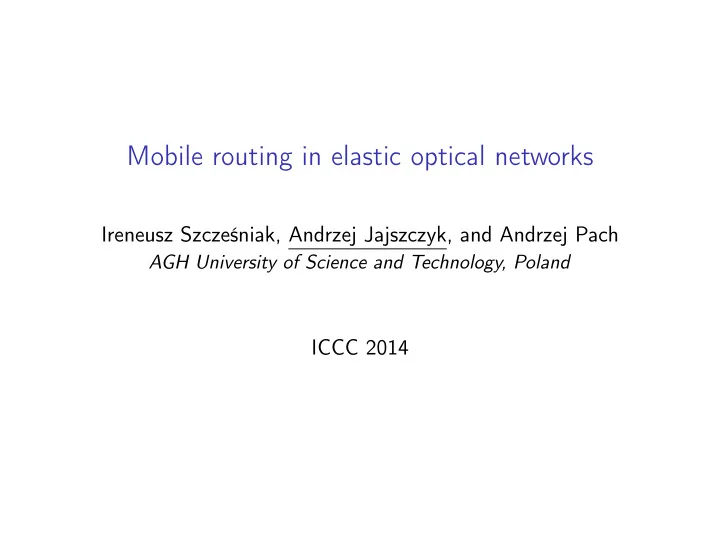

Mobile routing in elastic optical networks Ireneusz Szcześniak, Andrzej Jajszczyk, and Andrzej Pach AGH University of Science and Technology, Poland ICCC 2014
Introduction Problem statement Solutions Simulation results Conclusion Plan of presentation • Introduction • Problem statement • Solutions • Simulation results • Conclusion Slide 2
Introduction Problem statement Solutions Simulation results Conclusion Background • Mobile traffic has increased manyfold and will increase further. • Hundreds of Mb/s - client download data rates in LTE-Advanced • Elastic optical networks (EONs) are very likely to succeed. • Currently optical subcarriers have the 6.25 GHz channel spacing. Slide 3
Introduction Problem statement Solutions Simulation results Conclusion Motivation • Gb/s - planned client download data rates for 5G • Optical subcarriers with narrow channel spacings could directly support mobile clients. • A client can be an emergency vehicle, a train or a bus. • Objective: support for mobile routing in EONs Slide 4
Introduction Problem statement Solutions Simulation results Conclusion Problem statement • An EON services a given number of mobile clients. • There is an optical connection established for a mobile client. • As the client roams, the source node of the connection changes, while the remote node stays the same. • Client roaming requires optical link reconfigurations. • Link reconfigurations are critical, because they can take a long time, and can cause service disruption. • Objective: design a reconfiguration algorithm to limit the number of link reconfigurations. Slide 5
Introduction Problem statement Solutions Simulation results Conclusion Reconfiguration algorithms studied • Complete (baseline algorithm): • find a shortest path between the new source node and the remote node; • no constraints needed. • Incremental (baseline algorithm): • find a bridging path between the new source node and the previous source node; • spectrum continuity constraint applies. • Curtailing (our contribution): • find a bridging path with the smallest number of hops between the new source node and any of the nodes of the already-established path; • spectrum continuity constraint applies. Slide 6
Introduction Problem statement Solutions Simulation results Conclusion Examples An already-established connection (dashed line) between the previous source node 1 and the remote node 4 has to be reconfigured. The new source node is node 5. Reconfigured connection is painted dotted-gray. 2 3 2 3 2 3 1 4 1 4 1 4 5 6 5 6 5 6 complete incremental curtailing • Complete: no links reused, two new links to configure. • Incremental: fails, requires the dotted-red bridging path, but link 1-2 already has the required subcarriers taken by this connection. • Curtailing: one link reused, one new link to configure. Slide 7
Introduction Problem statement Solutions Simulation results Conclusion Simulation setting • Simulations carried out to compare the performance of the three routing algorithms and two spectrum allocation policies. • Spectrum allocation policies used: • first available - subcarriers with the lowest number are chosen, • fittest available - a smallest fragment of subcarriers is chosen which can still accommodate the demand. • Random networks with 50 nodes, 200 edges, and 400 subcarriers. • The number of clients varied from 500 to 10000 with step 500, which produced loads from light to heavy, respectively. • Clients change their states between active and idle. When active, a client attempts Poisson( λ t = 7) reconfigurations every Poisson( λ stay = 1) hours, and then goes idle for Poisson( λ idle = 16) hours. • A client requests Poisson( λ sc = 2) subcarriers. Slide 8
Introduction Problem statement Solutions Simulation results Conclusion Simulation results • There are 120 samples (20 loads x 3 algorithms x 2 policies) • Each sample had 10 runs, resulting in 1200 simulation runs. • The relative standard error of the results is below 1%. • A data point in plots (which follow) corresponds to a sample. • Key measured values: • number of new links to configure, • probability of establishing a connection, • probability of completing a connection. • There are six data sets in plots (3 algorithms x 2 policies): complete, fittest incremental, fittest curtailing, fittest complete, first incremental, first curtailing, first Slide 9
Introduction Problem statement Solutions Simulation results Conclusion Number of new links to configure 2 . 5 • The number of new links to number of new links configure during 2 reconfiguration. • The curtailing algorithm outperforms the other two 1 . 5 algorithms. • Spectrum allocation policy 1 makes little difference. 0 0 . 2 0 . 4 0 . 6 0 . 8 network utilization complete, fittest incremental, fittest curtailing, fittest complete, first incremental, first curtailing, first Slide 10
Introduction Problem statement Solutions Simulation results Conclusion Probability of establishing a connection 1 0 . 95 probability • Refers to a new connection. 0 . 9 • All three algorithms perform in a similar way. 0 . 85 0 . 8 0 0 . 2 0 . 4 0 . 6 0 . 8 network utilization complete, fittest incremental, fittest curtailing, fittest complete, first incremental, first curtailing, first Slide 11
Introduction Problem statement Solutions Simulation results Conclusion Probability of completing a connection 1 • The probability that a client makes a number 0 . 9 Poisson( λ t = 7) of probability successful reconfigurations. 0 . 8 • The curtailing algorithm performs best. 0 . 7 • Again, spectrum allocation policy makes little difference. 0 0 . 2 0 . 4 0 . 6 0 . 8 network utilization complete, fittest incremental, fittest curtailing, fittest complete, first incremental, first curtailing, first Slide 12
Introduction Problem statement Solutions Simulation results Conclusion Conclusion • We proposed a mobile routing algorithm for elastic optical networks. • We achieved the key objective of lowering the number of new links to configure, which is required by reconfiguration. • The proposed algorithm achieves high probabilities of establishing and completing connections. • The algorithm could be also used in link restoration in EONs. Slide 13
Recommend
More recommend